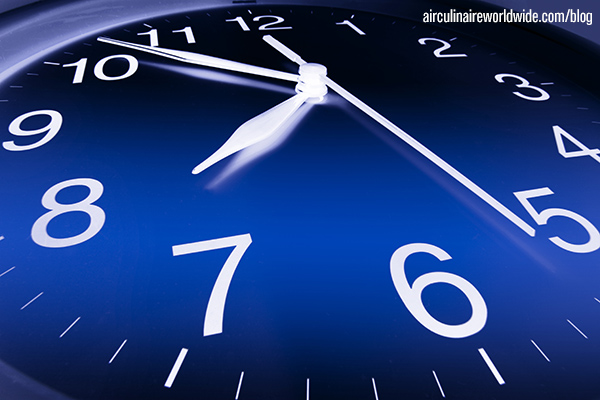We often emphasize the control of time and temperature as being a critical factor in keeping our catering safe, but what does this actually mean to us? One of the major hazards to food safety is the presence of harmful bacteria in our onboard catering, and it being allowed to grow to harmful levels. This could lead to severe illness or worse, especially for those passengers in at risks groups *(People who are immuno-compromised, infants, the elderly and expectant mothers)
Temperature
Bacteria will grow very rapidly in foods kept at ambient temperatures, especially in high-risk foods. The temperature range between 5 C to 60 C (40 F to 140 F) is called The Temperature Danger Zone (TDZ). In the United Kingdom, we expand this range to 63 C (145 F) as this is the legal limit for hot holding food. It is vital the amount of time that foods are kept in this temperature range is kept to a minimum. Most bacteria multiply rapidly over 20 C (68 F) and especially around 37 C (99 F) – which just happens to be the temperature of the human body! Outside the TDZ, bacteria either stops growing or grows very slowly.
To prevent bacteria multiplying the and risk of illness, hot food should be kept hot (above 60 C / 140 F) and cold food kept cold (5 C /140 F or below). High temperatures are required for cooking to ensure any harmful bacteria are destroyed. Hot food should be cooked to an internal core temperature of at least 75 C (167 F) for 30 seconds.
Some bacteria are spore formers, and will produce toxins when they multiply – whilst the bacteria may be destroyed by thorough cooking, the toxins which can cause severe illness will remain. For this reason, food must always be kept outside the TDZ and only ever reheated once!
Critical Food Temperatures to Remember
- Cooking temperature best practice – 75 C (167 F) for 30 seconds
- Scotland legal cooking temperatures – 82 C (180 F)
- The Temperature Danger Zone 5 C – 60 C (41 F – 140 F)
- Hot holding of food – 63 C (145 F) or above
This all sounds very simple in practice. However, our working environment often is anything but. Some aircraft do not have chillers, which presents a huge safety implication, especially on long sectors. Some chillers only work when airborne, on gasper air or take time to chill down. Do you check your chiller temperatures inflight? A refrigerator thermometer is inexpensive and can be used to monitor temperatures. For hot food, a properly calibrated food temperature probe, or single-use food probe, should be used. If catering from restaurants and hotels, the catering could be at risk of sitting in ambient temperatures after preparation and during transit. We must consider how we will keep our catering out of the TDZ – catering must be kept either chilled or hot held.
If using an aviation caterer, every step of our catering preparation is monitored and the catering held at the correct temperature up until to delivery. Thus, alleviating this issue.
Time
Time also plays a significant role in food safety. Under favorable conditions, bacteria can multiply every 20 minutes. In a short space of time, a few hundred bacteria could become millions. This is just an average; if the outside temperature is particularly warm, this time can be reduced considerably. The entire time the catering is in transit, passing through the FBO, airport, sat on the aircraft or sat on the galley countertop, the clock is ticking down and the safety shelf life of your catering is rapidly decreasing!
Chilled Food
If chilled food is kept in the TDZ, it has a safety shelf life of 4 hours. After this, bacteria could potentially be at harmful levels (this would be from the time the food is prepared, not when your reach the aircraft or pick it up). Provision for safe, temperature-controlled transportation must always be made – especially for high-risk foods. If collecting foods such as sushi, caviar, catering from a high-end supermarket, you must ensure that the catering is kept chilled for transit and while onboard.
Hot Food
Hot food must be hot held above 60 C (140 F) to prevent bacterial multiplication, legal limits vary depending upon the country you are in. (As mentioned, in the United Kingdom the legal minimum for holding hot food is 63 C (145 F). If hot food cannot be hot held above this, it has a safety shelf life of just two hours from the time of preparation. After this, it must be discarded as the bacteria could now be at illness causing levels. This is always a big consideration when procuring food from a hotel or restaurant. How much time has elapsed since the catering was prepared and you took delivery? How are you going to keep the food at a safe temperature? What specifics have you given to ensure its safe preparation and transportation?
Questions?
If you have any questions about this article, contact Yasmin Milner at ymilner@corporateflighttraining.com.
| This is an article by guest author Yasmin Milner of Corporate Flight Training. Yasmin is based in the United Kingdom and is an industry expert in corporate aviation. Any thoughts expressed in this article are entirely Yasmin’s and do not necessarily reflect the views of Air Culinaire Worldwide. |
If you would like to be considered for becoming a guest author, please contact socialmedia@airculinaire.com.






